MNG81001: Management Communication - Virtual Workforce Report
VerifiedAdded on 2023/06/08
|8
|1462
|448
Report
AI Summary
This report focuses on the management of virtual teams, particularly within the context of a marketing team spread across Sydney, New York, Beijing, and Mumbai. It begins with an introduction to the concept of virtual teams and their increasing relevance in a globalized business environment. The report emphasizes the importance of effective communication and the challenges associated with managing geographically dispersed teams, including time zone differences, cultural gaps, and the absence of face-to-face interactions. It highlights issues such as misinterpretation of information and the need for trust and social bonding to ensure team success. The report provides recommendations for overcoming these challenges, drawing on existing research to suggest strategies for improving communication, building relationships, and leveraging technology to enhance team performance. The conclusion underscores the need for adaptable leadership and proactive problem-solving in managing virtual workforces to achieve efficiency and productivity.
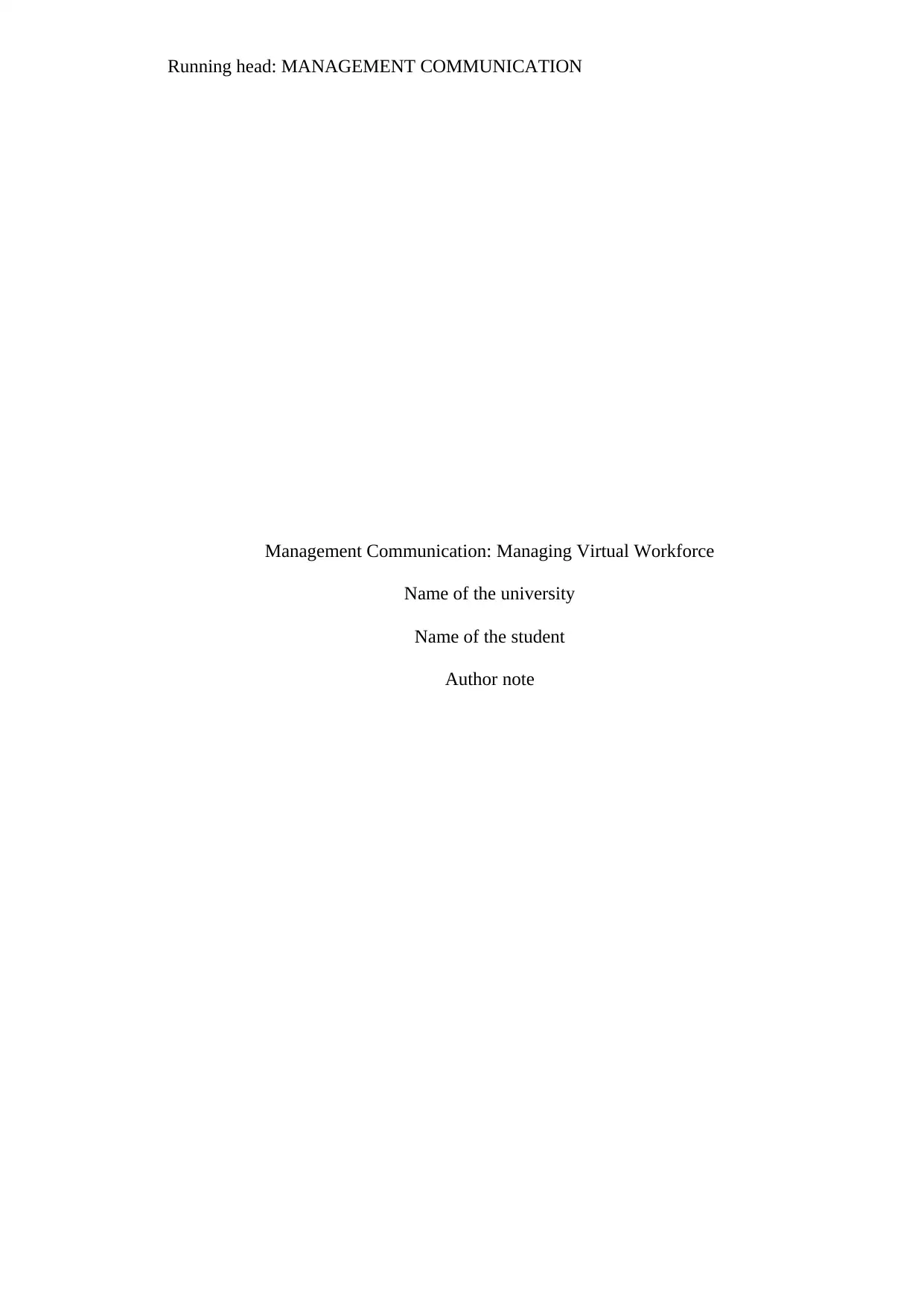
Running head: MANAGEMENT COMMUNICATION
Management Communication: Managing Virtual Workforce
Name of the university
Name of the student
Author note
Management Communication: Managing Virtual Workforce
Name of the university
Name of the student
Author note
Paraphrase This Document
Need a fresh take? Get an instant paraphrase of this document with our AI Paraphraser
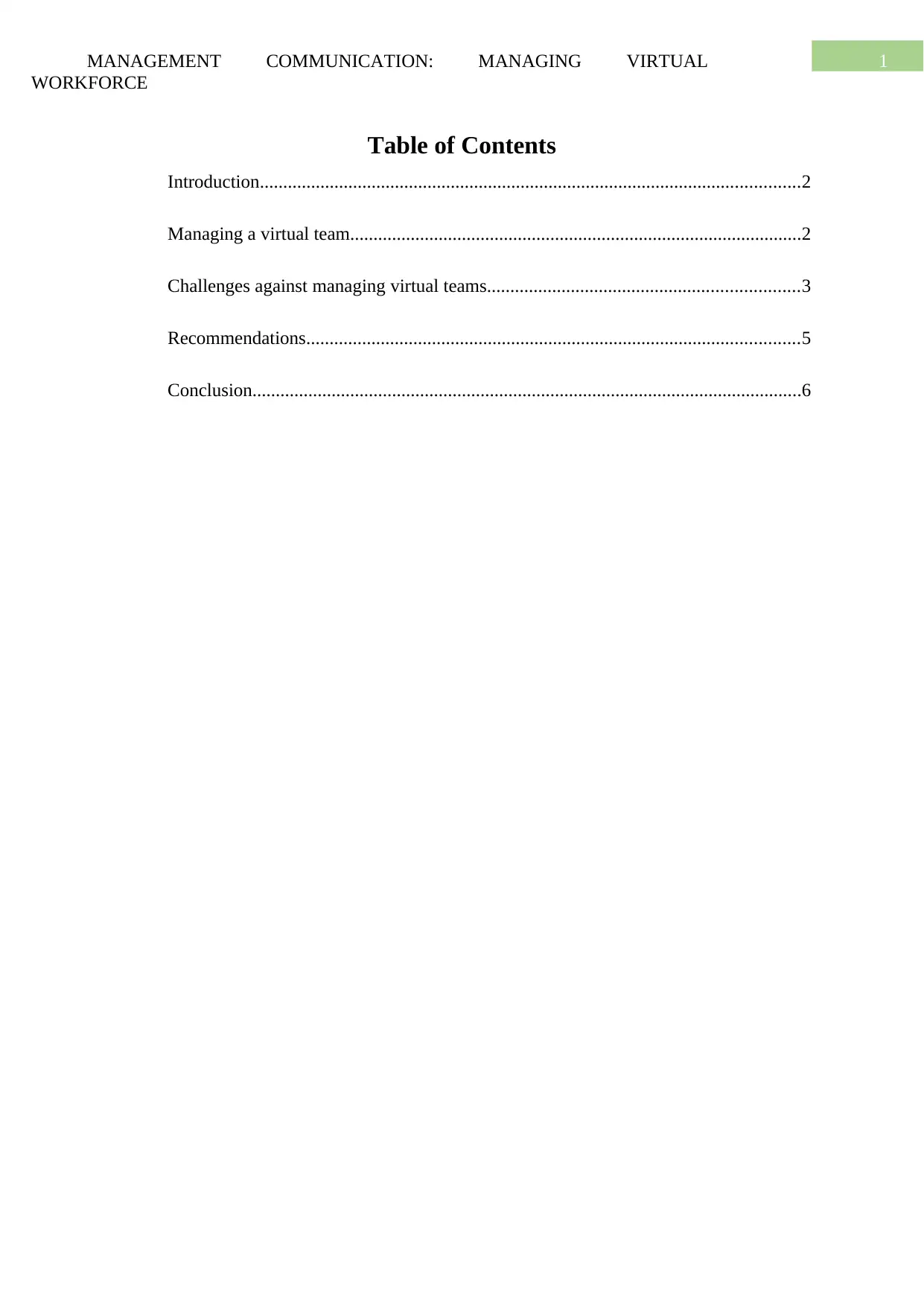
1MANAGEMENT COMMUNICATION: MANAGING VIRTUAL
WORKFORCE
Table of Contents
Introduction....................................................................................................................2
Managing a virtual team.................................................................................................2
Challenges against managing virtual teams...................................................................3
Recommendations..........................................................................................................5
Conclusion......................................................................................................................6
WORKFORCE
Table of Contents
Introduction....................................................................................................................2
Managing a virtual team.................................................................................................2
Challenges against managing virtual teams...................................................................3
Recommendations..........................................................................................................5
Conclusion......................................................................................................................6
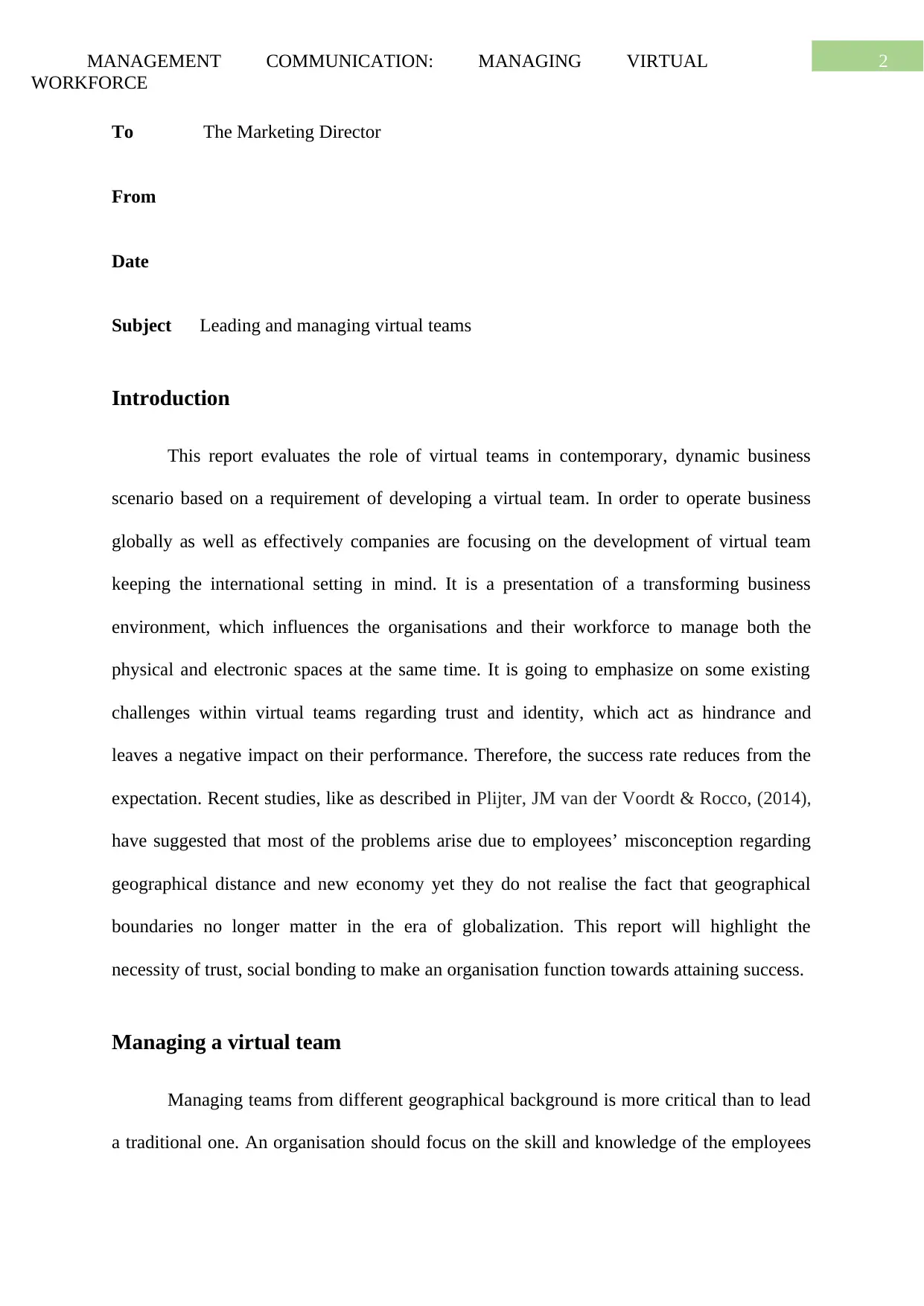
2MANAGEMENT COMMUNICATION: MANAGING VIRTUAL
WORKFORCE
To The Marketing Director
From
Date
Subject Leading and managing virtual teams
Introduction
This report evaluates the role of virtual teams in contemporary, dynamic business
scenario based on a requirement of developing a virtual team. In order to operate business
globally as well as effectively companies are focusing on the development of virtual team
keeping the international setting in mind. It is a presentation of a transforming business
environment, which influences the organisations and their workforce to manage both the
physical and electronic spaces at the same time. It is going to emphasize on some existing
challenges within virtual teams regarding trust and identity, which act as hindrance and
leaves a negative impact on their performance. Therefore, the success rate reduces from the
expectation. Recent studies, like as described in Plijter, JM van der Voordt & Rocco, (2014),
have suggested that most of the problems arise due to employees’ misconception regarding
geographical distance and new economy yet they do not realise the fact that geographical
boundaries no longer matter in the era of globalization. This report will highlight the
necessity of trust, social bonding to make an organisation function towards attaining success.
Managing a virtual team
Managing teams from different geographical background is more critical than to lead
a traditional one. An organisation should focus on the skill and knowledge of the employees
WORKFORCE
To The Marketing Director
From
Date
Subject Leading and managing virtual teams
Introduction
This report evaluates the role of virtual teams in contemporary, dynamic business
scenario based on a requirement of developing a virtual team. In order to operate business
globally as well as effectively companies are focusing on the development of virtual team
keeping the international setting in mind. It is a presentation of a transforming business
environment, which influences the organisations and their workforce to manage both the
physical and electronic spaces at the same time. It is going to emphasize on some existing
challenges within virtual teams regarding trust and identity, which act as hindrance and
leaves a negative impact on their performance. Therefore, the success rate reduces from the
expectation. Recent studies, like as described in Plijter, JM van der Voordt & Rocco, (2014),
have suggested that most of the problems arise due to employees’ misconception regarding
geographical distance and new economy yet they do not realise the fact that geographical
boundaries no longer matter in the era of globalization. This report will highlight the
necessity of trust, social bonding to make an organisation function towards attaining success.
Managing a virtual team
Managing teams from different geographical background is more critical than to lead
a traditional one. An organisation should focus on the skill and knowledge of the employees
⊘ This is a preview!⊘
Do you want full access?
Subscribe today to unlock all pages.

Trusted by 1+ million students worldwide
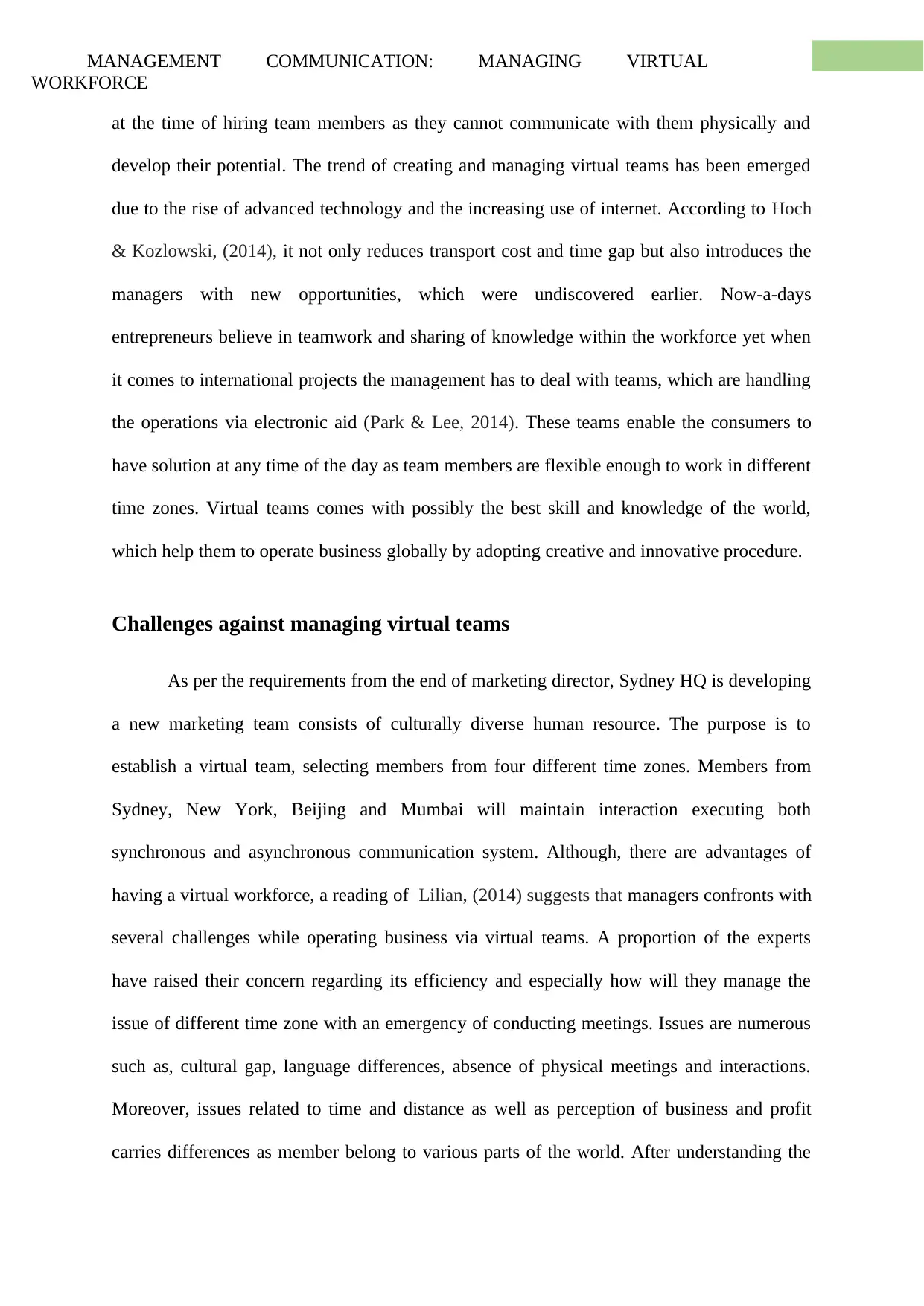
3MANAGEMENT COMMUNICATION: MANAGING VIRTUAL
WORKFORCE
at the time of hiring team members as they cannot communicate with them physically and
develop their potential. The trend of creating and managing virtual teams has been emerged
due to the rise of advanced technology and the increasing use of internet. According to Hoch
& Kozlowski, (2014), it not only reduces transport cost and time gap but also introduces the
managers with new opportunities, which were undiscovered earlier. Now-a-days
entrepreneurs believe in teamwork and sharing of knowledge within the workforce yet when
it comes to international projects the management has to deal with teams, which are handling
the operations via electronic aid (Park & Lee, 2014). These teams enable the consumers to
have solution at any time of the day as team members are flexible enough to work in different
time zones. Virtual teams comes with possibly the best skill and knowledge of the world,
which help them to operate business globally by adopting creative and innovative procedure.
Challenges against managing virtual teams
As per the requirements from the end of marketing director, Sydney HQ is developing
a new marketing team consists of culturally diverse human resource. The purpose is to
establish a virtual team, selecting members from four different time zones. Members from
Sydney, New York, Beijing and Mumbai will maintain interaction executing both
synchronous and asynchronous communication system. Although, there are advantages of
having a virtual workforce, a reading of Lilian, (2014) suggests that managers confronts with
several challenges while operating business via virtual teams. A proportion of the experts
have raised their concern regarding its efficiency and especially how will they manage the
issue of different time zone with an emergency of conducting meetings. Issues are numerous
such as, cultural gap, language differences, absence of physical meetings and interactions.
Moreover, issues related to time and distance as well as perception of business and profit
carries differences as member belong to various parts of the world. After understanding the
WORKFORCE
at the time of hiring team members as they cannot communicate with them physically and
develop their potential. The trend of creating and managing virtual teams has been emerged
due to the rise of advanced technology and the increasing use of internet. According to Hoch
& Kozlowski, (2014), it not only reduces transport cost and time gap but also introduces the
managers with new opportunities, which were undiscovered earlier. Now-a-days
entrepreneurs believe in teamwork and sharing of knowledge within the workforce yet when
it comes to international projects the management has to deal with teams, which are handling
the operations via electronic aid (Park & Lee, 2014). These teams enable the consumers to
have solution at any time of the day as team members are flexible enough to work in different
time zones. Virtual teams comes with possibly the best skill and knowledge of the world,
which help them to operate business globally by adopting creative and innovative procedure.
Challenges against managing virtual teams
As per the requirements from the end of marketing director, Sydney HQ is developing
a new marketing team consists of culturally diverse human resource. The purpose is to
establish a virtual team, selecting members from four different time zones. Members from
Sydney, New York, Beijing and Mumbai will maintain interaction executing both
synchronous and asynchronous communication system. Although, there are advantages of
having a virtual workforce, a reading of Lilian, (2014) suggests that managers confronts with
several challenges while operating business via virtual teams. A proportion of the experts
have raised their concern regarding its efficiency and especially how will they manage the
issue of different time zone with an emergency of conducting meetings. Issues are numerous
such as, cultural gap, language differences, absence of physical meetings and interactions.
Moreover, issues related to time and distance as well as perception of business and profit
carries differences as member belong to various parts of the world. After understanding the
Paraphrase This Document
Need a fresh take? Get an instant paraphrase of this document with our AI Paraphraser
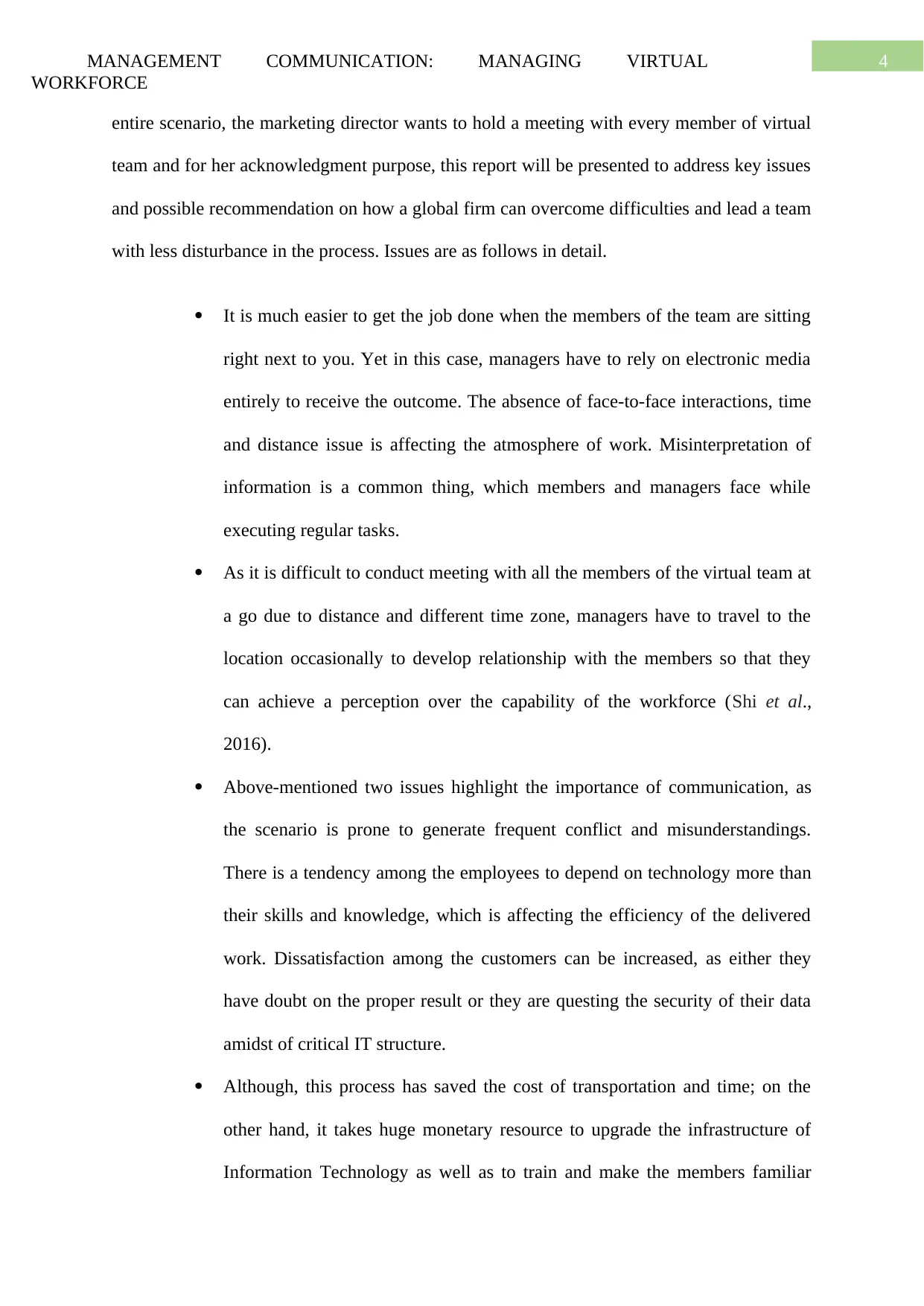
4MANAGEMENT COMMUNICATION: MANAGING VIRTUAL
WORKFORCE
entire scenario, the marketing director wants to hold a meeting with every member of virtual
team and for her acknowledgment purpose, this report will be presented to address key issues
and possible recommendation on how a global firm can overcome difficulties and lead a team
with less disturbance in the process. Issues are as follows in detail.
It is much easier to get the job done when the members of the team are sitting
right next to you. Yet in this case, managers have to rely on electronic media
entirely to receive the outcome. The absence of face-to-face interactions, time
and distance issue is affecting the atmosphere of work. Misinterpretation of
information is a common thing, which members and managers face while
executing regular tasks.
As it is difficult to conduct meeting with all the members of the virtual team at
a go due to distance and different time zone, managers have to travel to the
location occasionally to develop relationship with the members so that they
can achieve a perception over the capability of the workforce (Shi et al.,
2016).
Above-mentioned two issues highlight the importance of communication, as
the scenario is prone to generate frequent conflict and misunderstandings.
There is a tendency among the employees to depend on technology more than
their skills and knowledge, which is affecting the efficiency of the delivered
work. Dissatisfaction among the customers can be increased, as either they
have doubt on the proper result or they are questing the security of their data
amidst of critical IT structure.
Although, this process has saved the cost of transportation and time; on the
other hand, it takes huge monetary resource to upgrade the infrastructure of
Information Technology as well as to train and make the members familiar
WORKFORCE
entire scenario, the marketing director wants to hold a meeting with every member of virtual
team and for her acknowledgment purpose, this report will be presented to address key issues
and possible recommendation on how a global firm can overcome difficulties and lead a team
with less disturbance in the process. Issues are as follows in detail.
It is much easier to get the job done when the members of the team are sitting
right next to you. Yet in this case, managers have to rely on electronic media
entirely to receive the outcome. The absence of face-to-face interactions, time
and distance issue is affecting the atmosphere of work. Misinterpretation of
information is a common thing, which members and managers face while
executing regular tasks.
As it is difficult to conduct meeting with all the members of the virtual team at
a go due to distance and different time zone, managers have to travel to the
location occasionally to develop relationship with the members so that they
can achieve a perception over the capability of the workforce (Shi et al.,
2016).
Above-mentioned two issues highlight the importance of communication, as
the scenario is prone to generate frequent conflict and misunderstandings.
There is a tendency among the employees to depend on technology more than
their skills and knowledge, which is affecting the efficiency of the delivered
work. Dissatisfaction among the customers can be increased, as either they
have doubt on the proper result or they are questing the security of their data
amidst of critical IT structure.
Although, this process has saved the cost of transportation and time; on the
other hand, it takes huge monetary resource to upgrade the infrastructure of
Information Technology as well as to train and make the members familiar
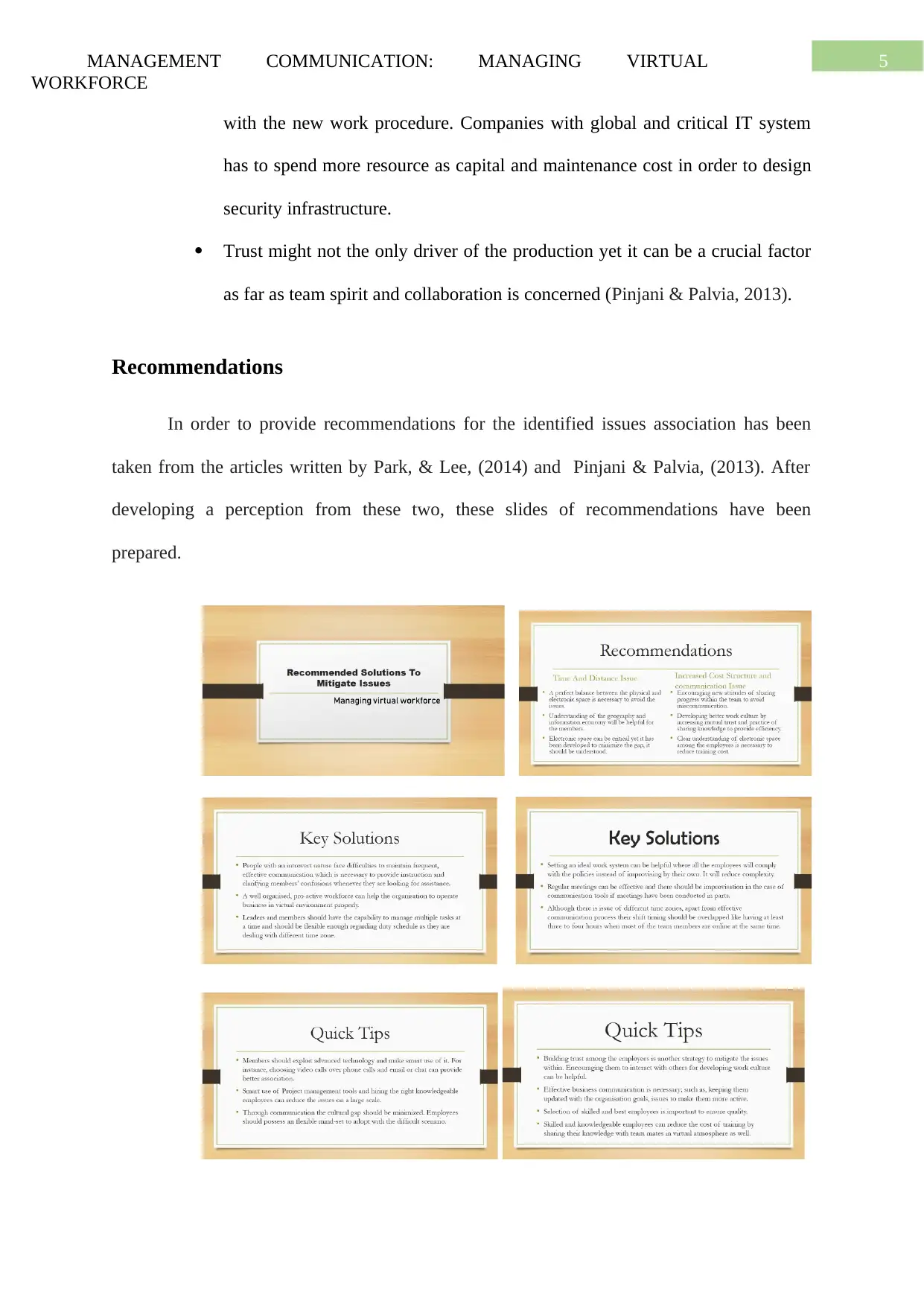
5MANAGEMENT COMMUNICATION: MANAGING VIRTUAL
WORKFORCE
with the new work procedure. Companies with global and critical IT system
has to spend more resource as capital and maintenance cost in order to design
security infrastructure.
Trust might not the only driver of the production yet it can be a crucial factor
as far as team spirit and collaboration is concerned (Pinjani & Palvia, 2013).
Recommendations
In order to provide recommendations for the identified issues association has been
taken from the articles written by Park, & Lee, (2014) and Pinjani & Palvia, (2013). After
developing a perception from these two, these slides of recommendations have been
prepared.
WORKFORCE
with the new work procedure. Companies with global and critical IT system
has to spend more resource as capital and maintenance cost in order to design
security infrastructure.
Trust might not the only driver of the production yet it can be a crucial factor
as far as team spirit and collaboration is concerned (Pinjani & Palvia, 2013).
Recommendations
In order to provide recommendations for the identified issues association has been
taken from the articles written by Park, & Lee, (2014) and Pinjani & Palvia, (2013). After
developing a perception from these two, these slides of recommendations have been
prepared.
⊘ This is a preview!⊘
Do you want full access?
Subscribe today to unlock all pages.

Trusted by 1+ million students worldwide
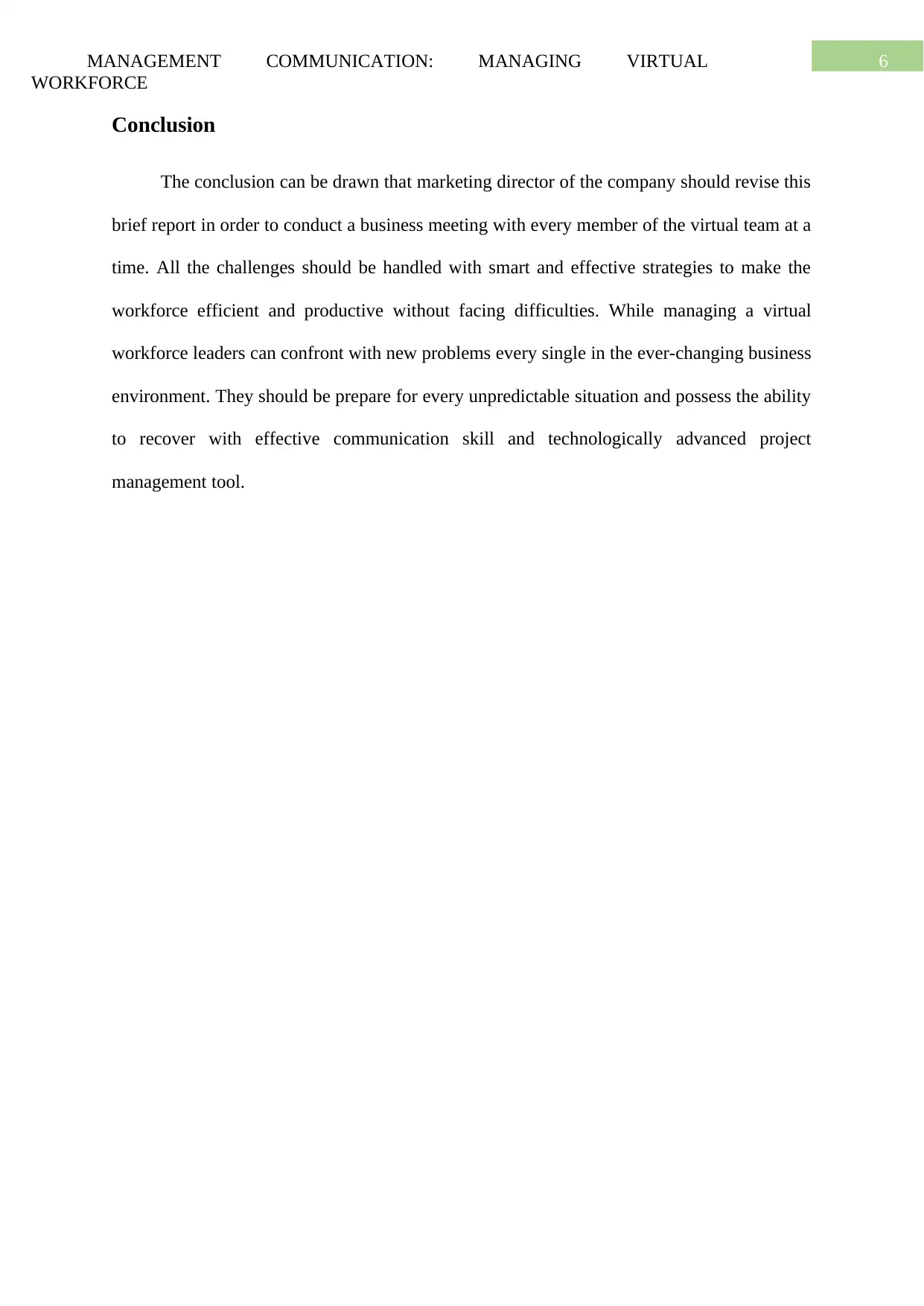
6MANAGEMENT COMMUNICATION: MANAGING VIRTUAL
WORKFORCE
Conclusion
The conclusion can be drawn that marketing director of the company should revise this
brief report in order to conduct a business meeting with every member of the virtual team at a
time. All the challenges should be handled with smart and effective strategies to make the
workforce efficient and productive without facing difficulties. While managing a virtual
workforce leaders can confront with new problems every single in the ever-changing business
environment. They should be prepare for every unpredictable situation and possess the ability
to recover with effective communication skill and technologically advanced project
management tool.
WORKFORCE
Conclusion
The conclusion can be drawn that marketing director of the company should revise this
brief report in order to conduct a business meeting with every member of the virtual team at a
time. All the challenges should be handled with smart and effective strategies to make the
workforce efficient and productive without facing difficulties. While managing a virtual
workforce leaders can confront with new problems every single in the ever-changing business
environment. They should be prepare for every unpredictable situation and possess the ability
to recover with effective communication skill and technologically advanced project
management tool.
Paraphrase This Document
Need a fresh take? Get an instant paraphrase of this document with our AI Paraphraser
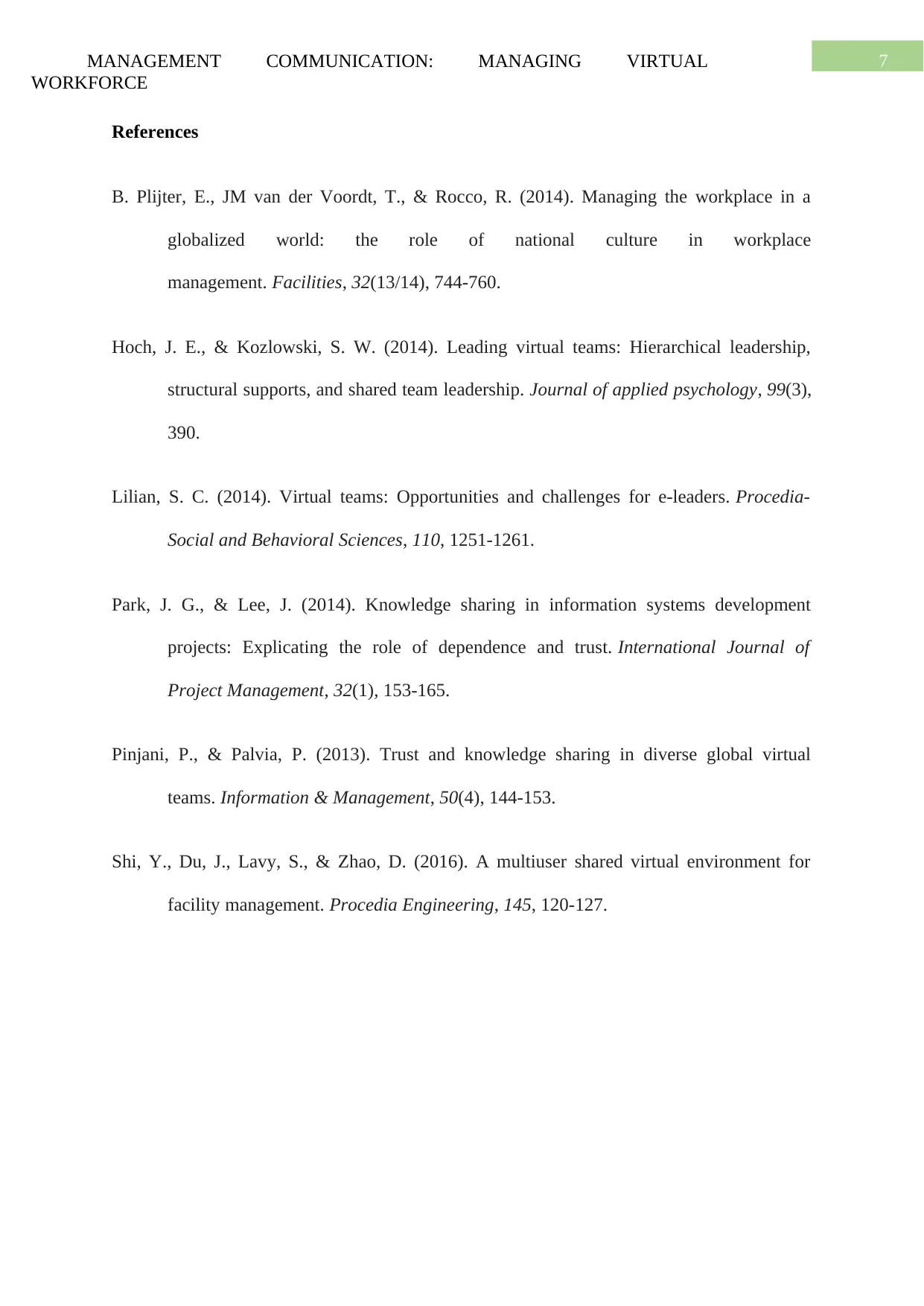
7MANAGEMENT COMMUNICATION: MANAGING VIRTUAL
WORKFORCE
References
B. Plijter, E., JM van der Voordt, T., & Rocco, R. (2014). Managing the workplace in a
globalized world: the role of national culture in workplace
management. Facilities, 32(13/14), 744-760.
Hoch, J. E., & Kozlowski, S. W. (2014). Leading virtual teams: Hierarchical leadership,
structural supports, and shared team leadership. Journal of applied psychology, 99(3),
390.
Lilian, S. C. (2014). Virtual teams: Opportunities and challenges for e-leaders. Procedia-
Social and Behavioral Sciences, 110, 1251-1261.
Park, J. G., & Lee, J. (2014). Knowledge sharing in information systems development
projects: Explicating the role of dependence and trust. International Journal of
Project Management, 32(1), 153-165.
Pinjani, P., & Palvia, P. (2013). Trust and knowledge sharing in diverse global virtual
teams. Information & Management, 50(4), 144-153.
Shi, Y., Du, J., Lavy, S., & Zhao, D. (2016). A multiuser shared virtual environment for
facility management. Procedia Engineering, 145, 120-127.
WORKFORCE
References
B. Plijter, E., JM van der Voordt, T., & Rocco, R. (2014). Managing the workplace in a
globalized world: the role of national culture in workplace
management. Facilities, 32(13/14), 744-760.
Hoch, J. E., & Kozlowski, S. W. (2014). Leading virtual teams: Hierarchical leadership,
structural supports, and shared team leadership. Journal of applied psychology, 99(3),
390.
Lilian, S. C. (2014). Virtual teams: Opportunities and challenges for e-leaders. Procedia-
Social and Behavioral Sciences, 110, 1251-1261.
Park, J. G., & Lee, J. (2014). Knowledge sharing in information systems development
projects: Explicating the role of dependence and trust. International Journal of
Project Management, 32(1), 153-165.
Pinjani, P., & Palvia, P. (2013). Trust and knowledge sharing in diverse global virtual
teams. Information & Management, 50(4), 144-153.
Shi, Y., Du, J., Lavy, S., & Zhao, D. (2016). A multiuser shared virtual environment for
facility management. Procedia Engineering, 145, 120-127.
1 out of 8
Related Documents
Your All-in-One AI-Powered Toolkit for Academic Success.
+13062052269
info@desklib.com
Available 24*7 on WhatsApp / Email
![[object Object]](/_next/static/media/star-bottom.7253800d.svg)
Unlock your academic potential
Copyright © 2020–2025 A2Z Services. All Rights Reserved. Developed and managed by ZUCOL.


